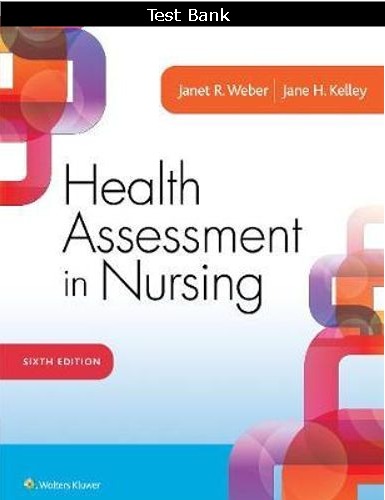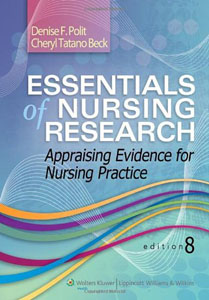Health Assessment in Nursing 6th Edition Test Bank
$55.00 Original price was: $55.00.$19.00Current price is: $19.00.
Digital item No Waiting Time Instant Download
-
ISBN-13: 978-1496344380ISBN-10: 1496344383
- Format: PDF
- Status: In Stock
- Language: English
- Authors: Janet R. Weber, Jane H. Kelley
- Publisher: LWW
Description
Health Assessment in Nursing 6th Edition Test Bank
Table of Contents
Unit I. Foundations for Health Assessment
1. Introduction to Health Assessment
2. Interviewing Patients to Obtain a Health History
3. Techniques and Equipment for Physical Assessment
4. General Inspection and Measurement of Vital Signs
5. Ethnic, Cultural, and Spiritual Considerations
6. Pain Assessment
7. Mental Health and Abusive Behavior Assessment
8. Nutritional Assessment
Unit II. Health Assessment of the Adult
9. Skin, Hair, and Nails
10. Head, Eyes, Ears, Nose, and Throat
11. Lungs and Respiratory System
12. Heart and Peripheral Vascular System
13. Abdomen and Gastrointestinal System
14. Musculoskeletal System
15. Neurologic System
16. Breasts and Axillae
17. Reproductive System and the Perineum
Unit III. Health Assessment Across the Life Span
18. Developmental Assessment Throughout the Life Span
19. Assessment of the Infant, Child, and Adolescent
20. Assessment of the Pregnant Patient
21. Assessment of the Older Adult
Unit IV. Synthesis and Application of Health Assessment
22. Conducting a Head-to-Toe Examination
23. Documenting the Head-to-Toe Health Assessment 24. Adapting Health Assessment to an Ill Patient
Appendixes
A. Abbreviations
B. Answer Key IBC: Special Features
Chapter 1 Nurses Role in Health Assessment- Collecting and Analyzing Data
A nurse on a postsurgical unit is admitting a client following the client’s
cholecystectomy (gall bladder removal). What is the overall purpose of the assessment for
this client?
A) Collecting accurate data
B) Assisting the primary care provider
C) Validating previous data
D) Making clinical judgments
2. A client has presented to the emergency department (ED) with complaints of abdominal
pain. Which member of the care team would most likely be responsible for collecting
the subjective data on the client during the initial comprehensive assessment?
A) Gastroenterologist
B) ED nurse
C) Admissions clerk
D) Diagnostic technician
3. The nurse has completed an initial assessment of a newly admitted client and is applying
the nursing process to plan the client’s care. What principle should the nurse apply when
using the nursing process?
A) Each step is independent of the others.
B) It is ongoing and continuous.
C) It is used primarily in acute care settings.
D) It involves independent nursing actions.
4. The nurse who provides care at an ambulatory clinic is preparing to meet a client and
perform a comprehensive health assessment. Which of the following actions should the
nurse perform first?
A) Review the client’s medical record.
B) Obtain basic biographic data.
C) Consult clinical resources explaining the client’s diagnosis.
D) Validate information with the client.
5. Which of the following client situations would the nurse interpret as requiring an
emergency assessment?
A) A pediatric client with severe sunburn
B) A client needing an employment physical
C) A client who overdosed on acetaminophen
D) A distraught client who wants a pregnancy test
6. In response to a client’s query, the nurse is explaining the differences between the
physician’s medical exam and the comprehensive health assessment performed by the
nurse. The nurse should describe the fact that the nursing assessment focuses on which
aspect of the client’s situation?
A) Current physiologic status
B) Effect of health on functional status
C) Past medical history
D) Motivation for adherence to treatment
7. After teaching a group of students about the phases of the nursing process, the instructor
determines that the teaching was successful when the students identify which phase as
being foundational to all other phases?
A) Assessment
B) Planning
C) Implementation
D) Evaluation
8. The nurse has completed the comprehensive health assessment of a client who has been
admitted for the treatment of community-acquired pneumonia. Following the
completion of this assessment, the nurse periodically performs a partial assessment
primarily for which reason?
A) Reassess previously detected problems
B) Provide information for the client’s record
C) Address areas previously omitted
D) Determine the need for crisis intervention
9. The nurse is working in an ambulatory care clinic that is located in a busy, inner-city
neighborhood. Which client would the nurse determine to be in most need of an
emergency assessment?
A) A 14-year-old girl who is crying because she thinks she is pregnant
B) A 45-year-old man with chest pain and diaphoresis for 1 hour
C) A 3-year-old child with fever, rash, and sore throat
D) A 20-year-old man with a 3-inch shallow laceration on his leg





Be the first to review “Health Assessment in Nursing 6th Edition Test Bank”